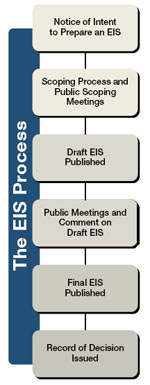The National Environmental Policy Act (NEPA) of 1969 requires the preparation of an Environmental Impact Statement (EIS) for major Federal actions that may significantly affect the quality of the environment. Under NEPA, the term "environment" encompasses the natural and physical environment (air, water, wildlife, and geology) as well as people's relationship with that environment (health and safety, jobs, housing, schools, transportation, cultural resources, noise, and aesthetics). The goal of Congress in enacting NEPA was to ensure that Federal agencies consider the potential environmental impacts of their proposed actions before deciding on a course of action.
An EIS is prepared in a series of steps: issuing a Notice of Intent (NOI) to begin the EIS process; gathering input from Federal agencies, State and local governments, and the public to define issues necessary for analysis (a process known as "scoping"); preparing the draft EIS; receiving and responding to public comments on the draft EIS; preparing the final EIS; and issuing a Record of Decision (ROD). Decisions are not made in an EIS; rather, an EIS is one of several factors decision makers must consider when deciding between various alternatives for a program or mission.
Major Steps in the EIS Process
 The procedures for completing an EIS have been established under NEPA for all Federal agencies. Individual agencies, including the National Aeronautics and Space Administration (NASA), have established their own implementing regulations and guidance to meet or exceed these requirements (NASA Procedural Requirements 14 CFR Subpart 1216.3 and guidance; NPR 8580.1). The major steps in the development of an EIS are outlined in the following discussion.
The procedures for completing an EIS have been established under NEPA for all Federal agencies. Individual agencies, including the National Aeronautics and Space Administration (NASA), have established their own implementing regulations and guidance to meet or exceed these requirements (NASA Procedural Requirements 14 CFR Subpart 1216.3 and guidance; NPR 8580.1). The major steps in the development of an EIS are outlined in the following discussion.
Image right: The major steps in the EIS process.
Notice of Intent and Scoping Process
A Federal agency first issues a NOI to prepare an EIS. The NOI is published in the Federal Register to inform the public that an EIS will be prepared, and to formally announce the beginning of the scoping process. The NOI describes the proposed action and alternatives the agency is considering; provides information on issues and potential impacts; and invites comments, questions, and suggestions on the scope of the EIS. In the process known as scoping, the public provides comments directly to the Federal agency on the scope of the EIS. This aids the Federal agency in determining the alternatives, issues, and environmental impacts to be analyzed in the EIS. Scoping can involve public meetings, written comments, or other means to obtain public views on the EIS.
Draft EIS
The draft EIS is the next step in the NEPA process. It describes, analyzes, and compares the potential environmental impacts of the alternatives and their implementation, and provides additional information on the methodologies and assumptions used for the analyses.
Public Comment on the Draft EIS
Once the draft EIS is issued, NEPA provides a minimum of 45 days for Federal agencies, State and local governments, and the public to comment on it. Meetings may be held during the comment period to facilitate receiving comments directly from Federal agencies, State and Local governments, and the public. The public comment period begins upon publication of a Notice of Availability (NOA) for the draft EIS in the Federal Register. Public comments are considered in the preparation of the final EIS.
Final EIS
Following the public comment period, a final EIS is published and distributed. The final EIS reflects consideration of all comments received during the public comment period, contains the agency's responses to those comments, and provides revised EIS text based upon comments received from the public. The final EIS will identify the agencies' preferred alternative(s). The release of the final EIS is announced by publishing a NOA in the Federal Register.
Record of Decision
Once the final EIS is published, a minimum 30-day waiting period is required before a Record of Decision (ROD) can be issued. A ROD notifies the public of the alternative that the agency has selected to proceed with and the reasons for that decision. The EIS analysis is considered as part of the decision-making process, which may also include consideration of other decision factors such as costs, technical feasibility, agency statutory mission, and/or national objectives.
National Environmental Policy Act
Purpose of NEPA: "To…encourage productive and enjoyable harmony between man and his environment; to promote efforts which will prevent or eliminate damage to the environment and biosphere and stimulate the health and welfare of man; to enrich the understanding of the ecological systems and natural resources important to the nation..." (condensed from NEPA)
The NEPA process does not dictate that an agency selects the most environmentally beneficial or least expensive alternative. The purpose of the NEPA process is to ensure that accurate environmental studies are performed, that they are done with public involvement, and that agencies make decisions based on an understanding of environmental consequences.
NEPA requires an EIS for proposed major Federal actions that could have significant impacts on the environment. An EIS looks at both the short-term and long-term effects of the proposed actions and considers possible mitigation measures.